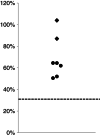Measurement of vancomycin hydrochloride concentration in the exudate from wounds receiving negative pressure wound therapy: a pilot study
- PMID: 24674131
- PMCID: PMC7949985
- DOI: 10.1111/iwj.12260
Measurement of vancomycin hydrochloride concentration in the exudate from wounds receiving negative pressure wound therapy: a pilot study
Abstract
It has been reported that negative pressure wound therapy (NPWT) is effective in the treatment of contaminated wounds. We hypothesised that systemically administered antibiotics migrate to wound site effectively by NPWT, which provides the antibacterial effect. We measured and compared the concentrations of vancomycin in the exudate and blood serum. Eight patients with skin ulcers or skin defect wounds who were treated with NPWT and were administered an intravenous drip of vancomycin were enrolled in this study. The wound surfaces were muscle, muscle fascia or adipose tissue. We administered vancomycin intravenously to NPWT patients (1-3 g/day). The exudate was obtained using 500 ml V.A.C. ATS canisters without gel. Three days later, the concentrations of vancomycin were measured. The mean concentration of vancomycin in the exudate from NPWT was 67% of the serum vancomycin concentration. We found that concentrations of vancomycin in NPWT exudates are higher than the previously reported concentrations in soft tissue without NPWT. The proactive use of NPWT might be considered in cases of suspected wound contamination when a systemic antibiotic is administered.
Keywords: Exudate; Infection; Negative pressure wound therapy; Vancomycin.
© 2014 The Authors. International Wound Journal © 2014 Medicalhelplines.com Inc and John Wiley & Sons Ltd.
Figures

 : wound surface is muscle or muscle fascia.
: wound surface is muscle or muscle fascia.  , wound surface is adipose tissue.
, wound surface is adipose tissue.  , previously reported vancomycin migration rate into the interstitial fluid.
, previously reported vancomycin migration rate into the interstitial fluid.References
-
- Krug E, Berg L, Lee C, Hudson D, Birke‐Sorensen H, Deoorter M, Dunn R, Jeffery S, Duteille F, Bruhin A, Caravaggi C, Chariker M, Dowsett C, Ferreira F, Francos Martinez JM, Grudzien G, Ichioka S, Ingemansson R, Malmsjo M, Rome P, Vig S, Runkel N, Martin R, Smith J. Evidence‐based recommendations for the use of negative pressure wound therapy in traumatic wounds and reconstructive surgery: steps towards an international consensus. Injury 2011;42:S1–12. - PubMed
-
- Moues CM, Vos MC, Van den bemd GCM, Stijnen T, Hovius SER. Bacterial load in relation to vacuum‐assisted closure wound therapy: a prospective randomized trial. Wound Repair Regen 2004;12:11–7. - PubMed
-
- Lalliss SJ, Stinner DJ, Waterman SM, Branstetter JB, Masini BD, Wenke JC. Negative pressure wound therapy reduces Pseudomonas wound contamination more than Staphylococcus aureus . J Orthop Trauma 2010;24:598–602. - PubMed
-
- Internal materials from Shionogi & Co., Ltd., Manufacturer of vancomycin. URL http://www.tryx‐ph.co.jp/image/VCM%81@IF%203%20200705.pdf [accessed on 10 February 2014]
-
- Brunton LL, Lazo JS, Parker KL. Goodman and Gilman's the pharmacological basis of therapeutics, 11th edn. McGraw‐Hill: New York, 2006:13.
MeSH terms
Substances
LinkOut - more resources
Full Text Sources
Other Literature Sources
Medical

